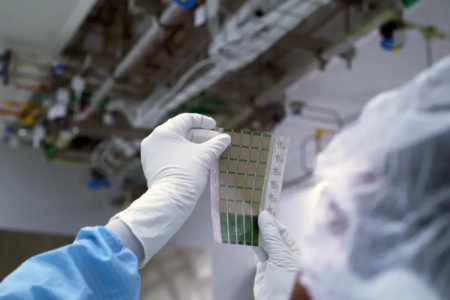
Thin-film solar cells weigh about 100 times less than conventional solar cells, while producing about 18 times more energy per kilogram of weight. A group of researchers has developed a new method of producing ultra-thin and light solar cells that can be easily integrated on any surface. New ultra-light fabric solar cells that can easily and quickly turn any surface into a source of energy. The study was published in the journal Small Methods.

The elements, which are much thinner than a human hair, are glued to a strong and light fabric, which makes it easy to install them on a fixed surface. They can provide power as a wearable energy fabric, and can be rapidly deployed to remote locations to provide assistance in emergency situations. They are 100 times lighter than conventional solar panels, generate 18 times more energy per kilogram, and are made from semiconductor ink using printing processes that can be scaled to large areas of fabric in the future.
Solar cells can be laminated to various surfaces. For example, they can be integrated into the sails of a boat to provide food at sea, attached to tents and tarpaulins, or mounted on the wings of drones to increase their flight range. The technology can be easily integrated into the built environment with minimal installation requirements.
Traditional silicon solar cells are fragile, so they must be encased in a glass case and packed in a heavy, thick aluminum frame, limiting their mounting options.
Tame Power BI and predict the future of your company.
REGISTER!
For the production of solar cells, nanomaterials are used in the form of electronic ink suitable for printing. Working in the MIT.nano clean room, the researchers created the structure of the solar cell using a coating device that screen-prints layers of electronic materials onto a prepared removable substrate as thin as 3 microns.
Then, a printed module with a thickness of about 15 mn was separated from the substrate.
Such thin autonomous solar modules are difficult to handle – they can easily break. To solve this problem, the MIT team sought a lightweight, flexible, and high-strength substrate for solar cells. They identified fabrics as the optimal solution because they provide mechanical strength and flexibility without adding much weight.
Engineers found the perfect material – a composite fabric weighing only 13g per square meter known as Dyneema. This fabric is made of fibers so strong that they were used as ropes to raise the sunken cruise ship Costa Concordia from the bottom of the Mediterranean Sea. By adding a layer of UV-curable glue just a few microns thick, the solar modules were attached to the sheets of this fabric.
“While it may seem simpler to simply print the solar cells directly onto the fabric, this will limit the selection of possible fabrics or other receiving surfaces to those that are chemically and thermally compatible with all the processing steps required to fabricate the devices. Our approach decouples the production of solar cells from their final integration,” explains study co-author Mayuran Saravanapavanantham, an MIT graduate student in electrical engineering and computer science.
The test energy-generating device assembled by the scientists can produce 730 W of energy per kilogram by itself, and about 370 W per kg when applied to Dyneema fabric. This is about 18 times the rate per unit mass of solar cells currently in use.
“A typical Massachusetts rooftop solar system is about 8,000 watts. To generate the same amount of energy, our fabric photovoltaics would only add about 20 kg of coverage to the roof of a house.”
Even after twisting and untwisting the fabric solar panel more than 500 times, the cells still retain more than 90% of their initial energy output.
Although the new solar cells are much lighter and much more flexible than traditional cells, they must be encased in a different material to protect them from the environment. The organic carbon-based material used to make the cells can be modified when exposed to moisture and oxygen in the air, which can impair their performance.
“Closing these solar cells with heavy glass, as is customary in traditional silicon solar cells, would minimize the value of the current achievement, so the team is currently developing ultra-thin packaging solutions that will only marginally increase the weight of the current ultralight devices. We are working to remove as much non-solar active material as possible while maintaining the form factor and performance of these ultra-lightweight and flexible solar structures. For example, we know that the manufacturing process can be further simplified by printing removable substrates, which is equivalent to the process we use to fabricate the other layers of our device. This will accelerate the introduction of this technology to the market.”
The research was funded by the MIT Energy Initiative, the US National Science Foundation and the Natural Sciences and Engineering Research Council of Canada.
Rating of the best portable solar panels in Ukraine – TOP 10 models of 2022
Source: SciTechDaily




